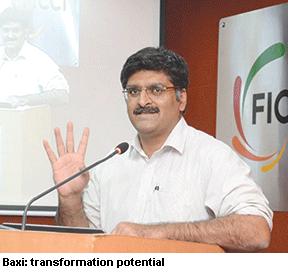The silver lining of the dark cloud looming over India’s sliding higher education system is the emergence of private universities from the shadow and peripheries of the system
 UNAPLOLGETICALLY DESCRIBED AS THE “sick child of Indian education” by the late unlamented Union HRD minister Arjun Singh, India’s government-dominated higher education system comprising a seemingly impressive 720 universities and 37,000 colleges, presents a bleak picture of obsolete curriculums, crumbling infrastructure, faculty shortages and funds constraints.
UNAPLOLGETICALLY DESCRIBED AS THE “sick child of Indian education” by the late unlamented Union HRD minister Arjun Singh, India’s government-dominated higher education system comprising a seemingly impressive 720 universities and 37,000 colleges, presents a bleak picture of obsolete curriculums, crumbling infrastructure, faculty shortages and funds constraints.
Unsurprisingly, not even one of them is listed in the league tables of the world’s Top 200 universities published annually by the London-based Quacquarelli Symonds (QS) and Times Higher Education.
Moreover, given India’s massive 1.2 billion population, the number of higher education institutions is grossly inadequate. They absorb a mere 25 percent of youth in this age group cf. the European average of 40-50 percent and over 80 percent in the US.
The silver lining of this dark cloud looming over India’s sliding higher education system is the emergence of private universities from the shadow and peripheries of the system. In the new millennium, the number of private universities has grown to 189 currently. Among them Manipal, Amity, VIT, Shiv Nadar, and NIIT universities offer globally benchmarked undergrad education, even if not comparable postgrad and research programmes.
However, it’s pertinent to note that almost all of India’s private universities were promoted to provide technical and professional engineering education, as a result of which liberal arts learning — left to Central and state government universities dominated by confused Leftist ideologues — has suffered grievously despite some of them (Bombay, Calcutta and Madras) being of more than 150 years vintage. This perhaps explains why even Delhi University (estb. 1922) — India’s top-ranked varsity — is ranked 421-430 and beyond 500 in the QS and THE World University Rankings respectively.
Against this backdrop of a continuous decline in liberal arts education, reflected in the rise to high positions in government and academia of narrowly-qualified technocrats inadequately schooled in political science, philosophy and economics, the quality of governance and academic standards have suffered dangerously. Indeed, it’s arguable that the breakdown of the social contract, law and order and justice machinery, and cancerous spread of corruption within Indian society are outcomes of continuous neglect of liberal arts education.
Therefore several new private initiatives to launch liberal arts universities and/or multi-disciplinary varsities with strong liberal arts schools, have aroused great hopes and expectation of a humanities learning renaissance. Among the new genre globally benchmarked liberal arts focused universities are Ashoka University, Kundli, Haryana (estb. 2014), O.P. Jindal University, Sonipat and the new Nalanda University, taking shape under the supervision of Nobel laureate Amartya Sen on the site of the ancient Nalanda University which in the 5th century and glory days of the subcontinent housed over 10,000 students from around the world.
“Our goal is to establish Ashoka as India’s finest university and one of the best in the world, founded on the principles of liberal learning. By offering world-class liberal education in India at a fraction of what it would cost in the US, Ashoka University will have a powerful demonstration effect in terms of what is possible in India,” promises Pramath Sinha, former partner of McKinsey Inc, founding dean of the Indian School of Business, Hyderabad and co-founder of Ashoka University, which admitted its first batch of 350 students in August.
THE OVERDUE LIBERAL ARTS renaissance which is so patently in the national interest apart, another revolutionary — inevitably offshore — development in higher education is the innovation of Moocs (massive open online courses). Currently over 40 Moocs providers are offering 20,000 online courses of 200 universities to 20 million students worldwide, including 2 million in India. Moocs providers such as edX, Coursera and Udacity, which offer study programmes of Harvard, MIT, Stanford and other top-ranked American universities, report that the second (after the US) highest enrolment in online courses is in India. Recently, two Indian institutions signed up with edX to offer their courses online. BITS, Pilani is using the edX platform to offer Moocs to its own students while IIT-Bombay is offering three online engineering programmes. Launched two months ago, IIT-Bombay’s Moocs have already attracted an enrolment of 35,000 students worldwide.
Within a higher education system plagued with outdated curriculums, faculty shortages and inadequate capacity, Moocs offer a magical opportunity to all students to sign up for free-of-charge high-quality tertiary education programmes. “The phenomenal growth of Moocs and the enthusiastic response of Indian learners marks a strategic inflection point for India’s higher education system. We need to seize the opportunity and quickly and decisively adopt systems and policies for Moocs-based education.
 Against the target of 30 percent GER (gross enrolment ratio) by 2030, Indian higher ed institutions and academic regulators need to urgently embrace Moocs. Learning through Moocs offers all Indians who want to learn, earn, teach or innovate, the capability to realise their true potential and transform our country,” says Vipalav Baxi, the Delhi-based founder of LearnOS Consulting Services Pvt. Ltd who has over 20 years of experience in e-learning and technology companies (Atelier, Servitium, eGurucool.com, and LIQVID) and is also convenor of FICCI’s higher education sub-committee on Moocs.
Against the target of 30 percent GER (gross enrolment ratio) by 2030, Indian higher ed institutions and academic regulators need to urgently embrace Moocs. Learning through Moocs offers all Indians who want to learn, earn, teach or innovate, the capability to realise their true potential and transform our country,” says Vipalav Baxi, the Delhi-based founder of LearnOS Consulting Services Pvt. Ltd who has over 20 years of experience in e-learning and technology companies (Atelier, Servitium, eGurucool.com, and LIQVID) and is also convenor of FICCI’s higher education sub-committee on Moocs.
The fervent and can-do determination which has suddenly and mysteriously emerged in Indian higher education, has also prompted the Haryana-based Hero Group of companies — the world’s largest producers of bicycles and automotive two-wheelers (scooters, motor-cycles) — to promote the BML Munjal University (BMU) in academic collaboration with the routinely Top 10 ranked Imperial College, London.
“Our education model, developed in conjunction with Imperial College, has been crafted to break boundaries between different academic disciplines, bridge the gap between theory and practice, integrate learning and living and, synchronize the classroom with the workplace. We are confident BMU will positively transform higher education in India,” says Akshay Munjal, a science and business management alum of Bradford University, UK, and Pepperdine University, USA, and executive director of BMU.
Even if belatedly there’s a flutter of activity within the complacent and somnolent groves of Indian academia which augurs well for India Inc and society in general